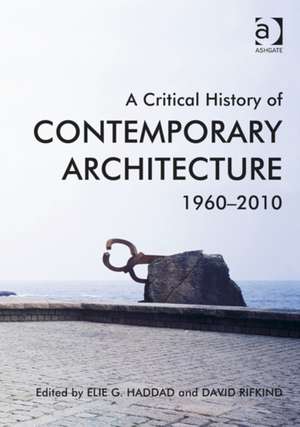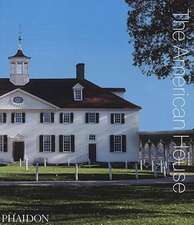A Critical History of Contemporary Architecture: 1960-2010
Autor Elie G. Haddad, David Rifkinden Limba Engleză Hardback – 26 mar 2014
Preț: 836.21 lei
Preț vechi: 1112.34 lei
-25% Nou
Puncte Express: 1254
Preț estimativ în valută:
160.02€ • 166.12$ • 133.44£
160.02€ • 166.12$ • 133.44£
Carte tipărită la comandă
Livrare economică 22 martie-05 aprilie
Preluare comenzi: 021 569.72.76
Specificații
ISBN-13: 9781472429377
ISBN-10: 1472429370
Pagini: 536
Dimensiuni: 174 x 246 x 39 mm
Greutate: 1.36 kg
Ediția:New.
Editura: Taylor & Francis
Colecția Routledge
Locul publicării:Oxford, United Kingdom
ISBN-10: 1472429370
Pagini: 536
Dimensiuni: 174 x 246 x 39 mm
Greutate: 1.36 kg
Ediția:New.
Editura: Taylor & Francis
Colecția Routledge
Locul publicării:Oxford, United Kingdom
Cuprins
Contents: Introduction: modernism and beyond: the plurality of contemporary architectures, Elie G. Haddad and David Rifkind. Part I Major Developments After Modernism: Modern (or contemporary) architecture circa 1959, Peter L. Laurence; Post-modernism: critique and reaction, David Rifkind; High-tech: modernism redux, Sarah Deyong; Deconstruction: the project of radical self-criticism, Elie G. Haddad; Greening architecture: the impact of sustainability, Phillip Tabb; Postcolonial theories in architecture, Esra Akcan. Part II Architectural Developments Around the World: Architecture in North America since 1960, Brendan Moran; Architectural developments in Latin America: 1960-2010, Zeuler R.M. de A. Lima; The place of commonplace: the ordinary as alternative architectural lens in Western Europe, Tom Avermaete; Dutch modern architecture: from an architecture of consensus to the culture of congestion, Frances Hsu; Metaphorical peripheries: architecture in Spain and Portugal, Xavier Costa; Architecture in Switzerland: a natural history, Laurent Stalder; Architecture in Eastern Europe and the former Soviet Union since 1960, Kimberley Elman Zarecor; Finland: architecture and cultural identity, Taisto H. Mäkelä; Architecture in Africa: situated modern and the production of locality, Iain Low; Global conflict and global glitter: architecture of West Asia (1960-2010), Esra Akcan; Old sites, new frontiers: modern and contemporary architecture in Iran, Pamela Karimi; Beyond tropical regionalism: the architecture of Southeast Asia, Kelly Shannon; Internationalism and architecture in India after Nehru, Amit Srivastava and Peter Scriver; Architecture in China in the reform era: 1978-2010, Tao Zhu; Architecture in post-World War II Japan, Ken Tadashi Oshima; Edge of centre: architecture in Australia and New Zealand after 1965, Philip Goad. Index.
Notă biografică
Dr Elie G. Haddad is the Dean of the School of Architecture and Design at the Lebanese American University, Lebanon and Dr David Rifkind is a Lecturer in Architecture at the Florida International University, USA.
Recenzii
With modern architecture's collapse as a unified body of thought and practice by the 1960s, the global field of architectural production has been marked by extraordinary diversity and innovation. This substantial volume ranges over wide territory, providing insightful critical and geographic perspectives on the last half century of architecture and locating the most significant points of reference for a revised historical understanding. The more than twenty contributors belong to a new generation of scholars. Carefully edited by Elie Haddad and David Rifkind and generously illustrated, this is an invaluable guide to architecture's recent past as well as to its present.
Joan Ockman, Author of Architecture Culture 1943-1968: A Documentary Anthology.
Joan Ockman, Author of Architecture Culture 1943-1968: A Documentary Anthology.
Descriere
This book provides a comprehensive, critical overview of the developments in architecture from 1960 to 2010. The first section provides a presentation of major movements in architecture after 1960, and the second, a geographic survey that covers a wide range of territories around the world. This book not only reflects the different perspectives of its various authors, but also charts a middle course between the 'aesthetic' histories that examine architecture solely in terms of its formal aspects, and the more 'ideological' histories that subject it to a critique that often skirts the discussion of its formal aspects.






